Andrew Phillips, of Selinsgrove, is an outdoor adventurer. He often backpacks into the wilds of Pennsylvania either biking, cycling or kayaking.
Now a college student at West Chester University, he has a fascination with the Susquehanna River.
“There is just something incredible about it. There are so many nooks and crannies to explore, each one completely unique,” he said.
So infatuated with the river, he joined a paddling expedition with the Chesapeake Bay Foundation’s Susquehanna Watershed Education Program while still a senior in high school, and it piqued his appetite to taste more of the river.
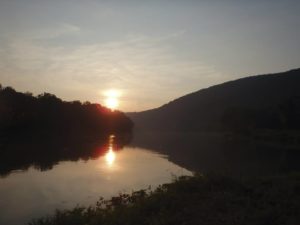
“I knew I would do the whole river pretty much one day,” he said.
That day came on June 5, 2014, when he and a friend, Mauricio Martinez, put their kayaks into the Susquehanna River at Cooperstown, New York. Their goal was to make it to Harve de Grace, Maryland where it empties into the Chesapeake Bay. The pair chose the early summer month not only because of the higher water level, but the heat would also be less when compared to August’s temperatures.
They were well prepared physically and chose their supplies carefully.
With a staple diet of Ramen noodles combined with a stew made from beans, coconut oil and some adobo, they planned on catching fish to supplement their meager meals.
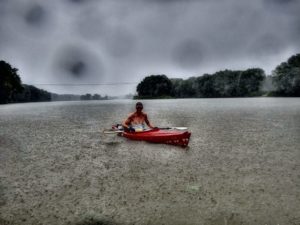
However, no matter how prepared they thought they were, the river had its own challenges. This would be no typical June weather-wise as the two would experience from the beginning.
“There were maybe five heavy – and I mean heavy – storms that rocked us,” Phillips said.
In fact, it rained ten of the 13 days on their kayaking expedition, with perhaps the most memorable rain-laced story coming from the final night of the journey.
“The last day, we got a little lazy. We didn’t tie the boats up well and we only pulled them onto shore. That night, it rained. It rained hard,” said Martinez. “By this point, we were as happy as anyone could be to be sleeping soundly in our damp, stinking sleeping bags with spiders crawling on our faces.
“I woke up at 4 a.m. and stepped out of the tent to check the boats, wearing just my shorts and a headlight. I peered into the night to discover our boats were bobbing on the waves 30 yards away. I grabbed my life vest and swam after them, slipping and cutting my feet on the sharp rocks. I got the boats back to shore, tied them up and went back to sleep.”

Bridge abutments offered them some protection against nature’s fury, but there were also times they had no where to go.
Below Selinsgrove, with about 100 miles left in the excursion, another downpour hit.
The two noticed a duck blind along the shore and headed for cover. Unfortunately, a nest of bees was waiting, and when the two adventurers found cover under a nearby tree, it turned out to be covered in poison ivy.
“The duck blind was a cruel bit of slapstick comedy relief,” Martinez said. “I was stung three times before backpedaling out of the blind and falling to the ground, bruising my butt and then rolling down a poison ivy-covered bank and landing in some soft mud in the water.”
Phillips said the two were constantly scratching.
“Between the stinging nettles, poison ivy, insects and wet clothing, we were pretty much itchy all the time,” he said.

There was only one time they considered turning back, and Phillips admits his stubbornness kept him forging ahead despite the obstacles. This time, he became physically ill.
“For me the uncertainty of what I should do was the hardest part of the situation, but I knew I was as emotionally prepared as someone could be,” he said.
What really got their adrenaline pulsating were the times they came upon unmarked low-head dams that were highly dangerous and could become life-threatening. Though the pair knew this, there was no way to know their exact location. “They can be impossible to see until you are right on top of them,” Phillips said.
“The one danger that requires the most homework for a trip like this are those dams,” Martinez said. “If someone wants to kayak the length of the river and stay safe, it should be a priority to learn where they are.”

At every twist and turn of the seemingly serene Susquehanna River, the river exhibited beauty and plenty of wildlife.
Below Towanda , the river makes an 180 degree before towering cliffs come into view.
“They were staggeringly impressive,” Phillips said.
Bald eagles were common along the trek. They saw more eagles on the lower Susquehanna, but also noticed three eyries in Sycamore trees along the shore.
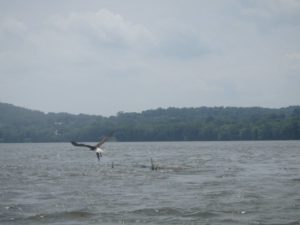
They were also thrilled with observing a group of otters near McKee’s Half Falls near Port Trevorton. Martinez also had quite a catch during the trip.
“Catching a big musky was definitely a highlight for me,” he said.
While most of the Susquehanna River was murky because of the excessive rainfall, the most pristine water was found in the first 40 miles.
“The water is a brilliant clear azure and it is absolutely magnificent,” Phillips said. He said that this is due to the fact that the headwaters still are unpolluted in this stretch.
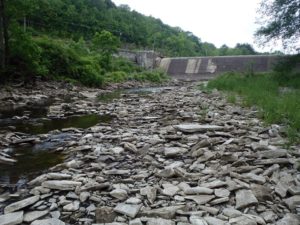
The most turbid water was around Wilkes-Barre to Sunbury, which the two feel is due to agricultural runoff.
Phillips said the trip gave him a heightened concern for the river’s fishery.
“They are facing assaults from all angles: pollution from agriculture, residential areas and industry, dammed waterways, thermal pollution and most currently pigmented tumors found on smallmouth bass,” Phillips said. “All of these pose a risk to the river and its life.”
Though Philips and Martinez did not kayak the Susquehanna River with the intention of conducting water quality tests, the two felt they saw enough to make some observations. Phillips believes the river isn’t as bad as what some people think, but he does admit it is under stress.
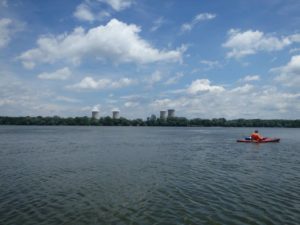
Finally after 13 days of kayaking, covering 30 to 40 miles a day, with heavy downpours, dangerous and challenging situations, the mighty Susquehanna opened up and the wide expanse of the Chesapeake Bay came into full view.
“It’s really an incredible sight,” Phillips said. “When the entirety of the river dawned on me at once, the whole experience came together. It was a surreal feeling.”
